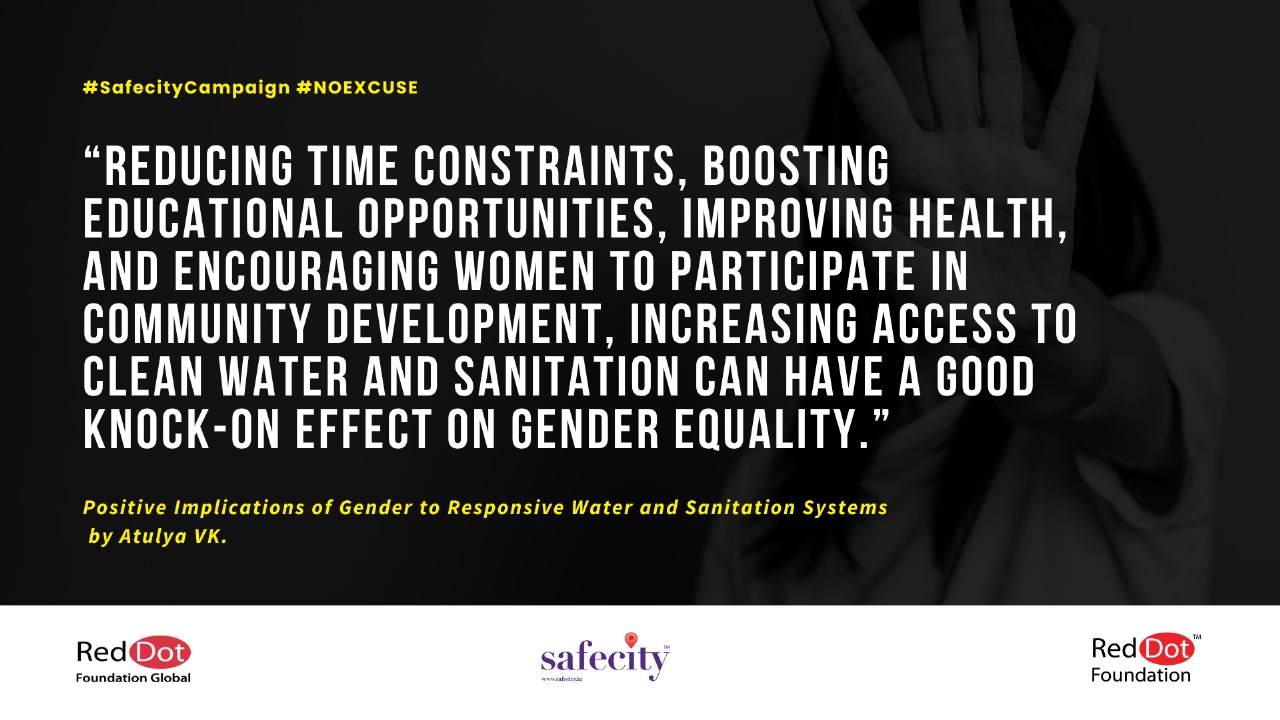Positive Implications of Gender to Responsive Water and Sanitation Systems

By Atulya VK.
We frequently experience a sense of immense satisfaction after downing a glass of water when exceedingly thirsty. As we drink that water in a moment of need, we get to understand the magnificence of this quenching exile that we, as humans, are bound to realize and appreciate in dire times. Being one of the undeniable necessities of life, water is the very reason for life to exist on earth. However, only a small percentage of its abundant existence can be consumed or drunk, as the majority of it resides in saline ocean water, ice caps, and glaciers. As a result, to maintain these levels of clean water and sanitation, the need for water management and sustainability arises through the implementation of SDG 6.
Now, if I were to ask you to picture how someone would fetch water, I’m sure you would instantly come across an image of women fetching water in containers and carrying it home. Even particular dance styles, such as the Chari dance, highlight the long-standing custom of women carrying buckets of water on their heads in Indian states, like Rajasthan. Although it is a magnificent dance form, it also subtly draws attention to the struggles faced by women who must trek long distances on foot just to get a few pots of water each day. However, this envisaged scenario of women trekking miles to get water for their families and essential requirements is still very evident even today in communities facing calamities or water shortages.
Access: Despite the efforts of numerous governments in developing and impoverished nations to improve the condition of access to water supplies, much work remains to be done in terms of building water connections in various rural and interior locations. Even though communal water connections are often accessible in rural regions, they might not be adequate for the entire community. In an effort to solve this problem of water access, various governments of developing and underdeveloped countries are seen to construct groundwater pumps in such rural areas. However, it becomes ineffective in times of calamity like famines and droughts, forcing people to migrate in quest of water as their villages run out of their groundwater reserves.
Gender-biased labor: Most of the time, society still expects women to clean and manage the household. Therefore, one can see women and girls being disproportionately affected by the absence of access to water and sanitation facilities because they are typically in charge of home chores such as fetching water and cleaning duties, which negatively affect their time, health, and educational opportunities. Moreover, the physical burnout and labor of walking and carrying water over long distances can be tiring, causing them physical pain like footaches, etc. As a result, better access to clean water and sanitation can help women and girls pursue chances for employment, education, and other aspirations by freeing up time and reducing their workload. Also, sanitation plays an important role in women’s lives. Especially the need to have a proper toilet and washroom fulfilling their requirements to have a private place to change. In this way, enhancing the availability of sanitary facilities and clean water can ease the burden on women and girls and advance gender equality.
Education: Particularly in impoverished areas, parents tend to pull their girls out of school as soon as they start their menstruation. But why do they do so all of a sudden? Well, a major part of the concern revolves around the comfort and sanitation-related issue itself. As in rural areas, girls may miss school during their menstrual cycle when schools lack adequate restrooms and sanitary facilities, which raises absenteeism and dropout rates. In these ways, the absence of sanitary facilities in classrooms are frequently seen to hinder girls from accessing their educational opportunities. Thus, through the implementation of projects such as Water, sanitation and hygiene (WASH) by the UN emphasizing on better cleanliness in schools and health-care services can have a direct influence on girls’ educational chances and gender equality.
Impact on Health: According to the World Health Organization, around 3.1% of deaths in the world are caused by unhygienic or poor-quality water. Inadequate access to clean water and sanitary facilities, particularly for women and girls, can have serious health consequences. Especially during and after their pregnancy, women should ensure the use of clean water and sanitize the objects near them and the new infant. On the other hand, women going through menstruation should be assured of sanitized facilities like proper toilets and sanitary pads. In this way, their safety and dignity will be maintained by the provision of sanitary facilities, especially in public areas. This enhanced women’s health, well-being, and overall standard of living can be achieved by improving access to sanitary facilities.
In conclusion, although SDG 6 and SDG 5 focus on distinct aspects of sustainable development, they are interlinked by the surrounding social, economic, and environmental components. By reducing time constraints, boosting educational opportunities, improving health, and encouraging women to participate in community development, increasing access to clean water and sanitation can have a good knock-on effect on gender equality. Therefore, with necessary cooperation between international organizations, local communities, NGOs, and governments one should acknowledge and tackle their interconnectedness in order to attain comprehensive and sustainable growth.
